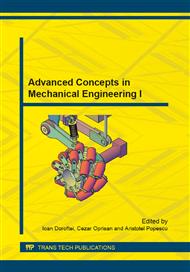p.245
p.249
p.255
p.261
p.271
p.277
p.283
p.289
p.295
Influence of the Geometry on the Rolling Friction Torque in Lubricated Ball-Race Contacts
Abstract:
Based on a theoretical model and an experimental methodology for defining the friction torque in a modified thrust ball bearing having only 3 balls and presented in [2], the authors experimentally investigated the influence of the ball diameter on friction torque when operating in mixed and full film lubrication conditions and maintaining the normal load, the race curvature and oil viscosity constant. The experiments were realized using ball diameters between 7.938 mm and 3 mm corresponding to maximum Hertzian pressure between 0.264 GPa and 1 GPa and a rotational speed between 60 rpm to 240 rpm. The experiments confirmed that the measured friction torque can be explained using hydrodynamic rolling force relationships respecting the transition from IsoViscous Rigid (IVR) to ElastoHydrodynamic Lubrication (EHL) regime presented in [2].
Info:
Periodical:
Pages:
271-276
Citation:
Online since:
October 2014
Price:
Сopyright:
© 2014 Trans Tech Publications Ltd. All Rights Reserved
Share:
Citation:


